The AMD Radeon R9 290X Review
by Ryan Smith on October 24, 2013 12:01 AM EST- Posted in
- GPUs
- AMD
- Radeon
- Hawaii
- Radeon 200
Bioshock Infinite
Bioshock Infinite is Irrational Games’ latest entry in the Bioshock franchise. Though it’s based on Unreal Engine 3 – making it our obligatory UE3 game – Irrational had added a number of effects that make the game rather GPU-intensive on its highest settings. As an added bonus it includes a built-in benchmark composed of several scenes, a rarity for UE3 engine games, so we can easily get a good representation of what Bioshock’s performance is like.
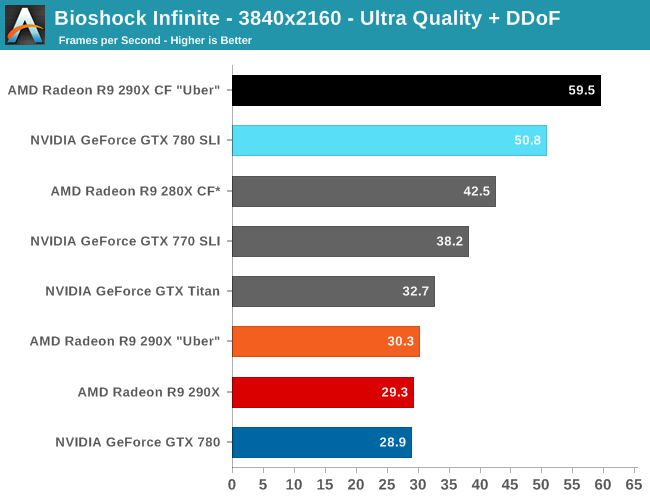

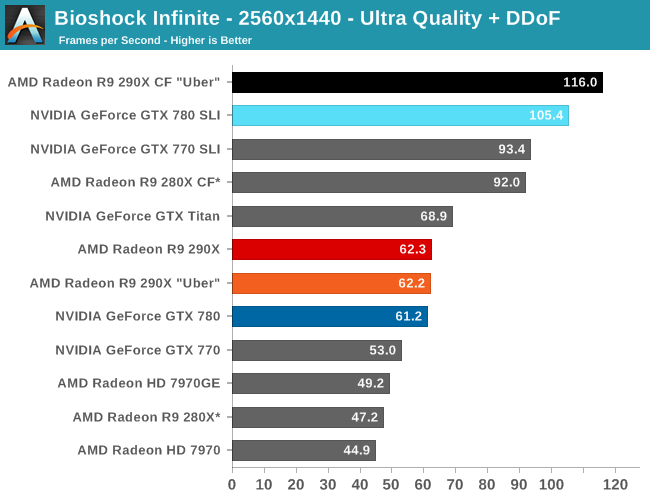
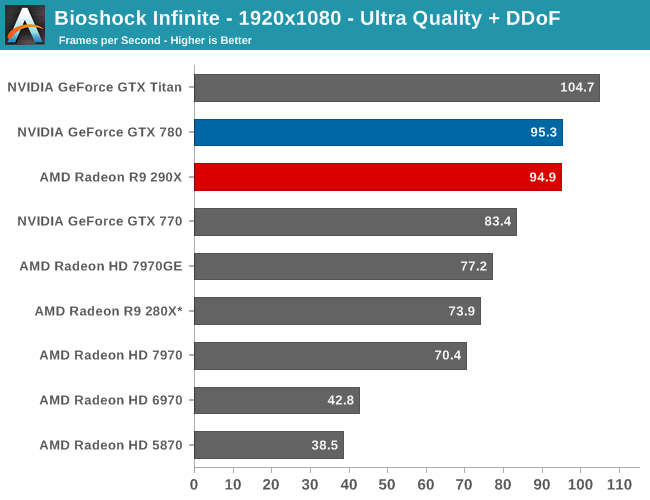
The first of the games AMD allowed us to publish results for, Bioshock is actually a straight up brawl between the 290X and the GTX 780 at 2560. The 290X’s performance advantage here is just 2%, much smaller than the earlier leads it enjoyed and essentially leaving the two cards tied, which also makes this one of the few games that 290X can’t match GTX Titan. At 2560 everything 290X/GTX 780 class or better can beat 60fps despite the heavy computational load of the depth of field effect, so for AMD 290X is the first single-GPU card from them that can pull this off.
Meanwhile at 4K things end up being rather split depending on the resolution we’re looking at. At Ultra quality the 290X and GTX 780 are again tied, but neither is above 30fps. Drop down to Medium quality however and we get framerates above 60fps again, while at the same time the 290X finally pulls away from the GTX 780, beating it by 14% and even edging out GTX Titan. Like so many games we’re looking at today the loss in quality cannot justify the higher resolution, in our opinion, but it presents another scenario where 290X demonstrates superior 4K performance.
For no-compromises 4K gaming we once again turn our gaze towards the 290X CF and GTX 780 SLI, which has AMD doing very well for themselves. While AMD and NVIDIA are nearly tied at the single GPU level – keep in mind we’re in uber mode for CF, so the uber 290X has a slight performance edge in single GPU mode – with multiple GPUs in play AMD sees better scaling from AFR and consequently better overall performance. At 95% the 290X achieves a nearly perfect scaling factor here, while the GTX 780 SLI achieves only 65%. Curiously this is better for AMD and worse for NVIDIA than the scaling factors we see at 2560, which are 86% and 72% respectively.
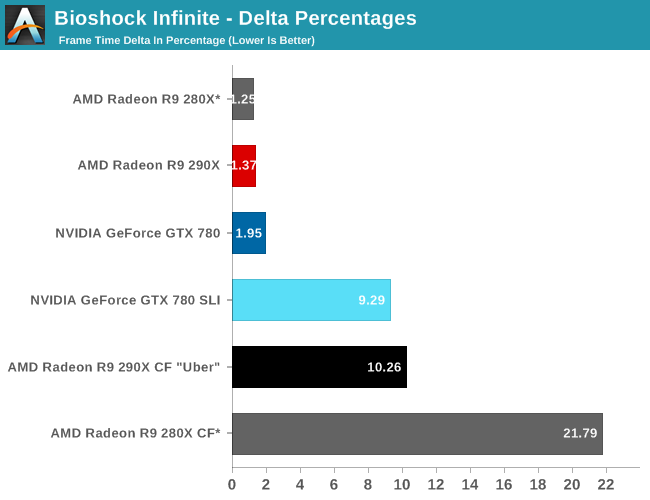

Moving on to our FCAT measurements, it’s interesting to see just how greatly improved the frame pacing is for the 290X versus the 280X, even with the frame pacing fixes in for the 280X. Whereas the 280X has deltas in excess of 21%, the 290X brings those deltas down to 10%, better than halving the variance in this game. Consequently the frame time consistency we’re seeing goes from being acceptable but measurably worse than NVIDIA’s consistency to essentially equal. In fact 10% is outright stunning for a multi-GPU setup, as we rarely achieve frame rates this consistent on those setups.
Finally for 4K gaming our variance increases a bit, but not immensely so. Despite the heavier rendering workload and greater demands on moving these large frames around, the delta percentages keep to 13%.


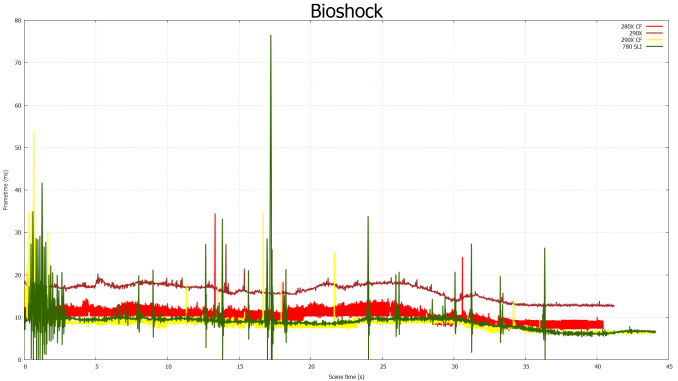









396 Comments
View All Comments
heflys - Thursday, October 24, 2013 - link
Slightly slower than a 780 overall? Even in Uber mode? Can you link me to these reviews if possible?Shark321 - Thursday, October 24, 2013 - link
I didn't say that. It's slightly slower in Uber Mode than Titan overall in 1080p (across all sites combined). In Quiet mode it's usually slightly faster than 780, slighttly slower in the minority of the reviews.heflys - Thursday, October 24, 2013 - link
I see now.Jumangi - Thursday, October 24, 2013 - link
What noob would buy a 290x or a Titan and run it in 1080p? A pointless resolution for these cards.
inighthawki - Thursday, October 24, 2013 - link
What an arrogant post. There are tons of people who game on 1080p displays and buy a 290X or a Titan. Having a high framerate (i.e. consistently greater than 60fps) reduces the likelihood of stuttering while playing, while also making your system a bit more future-proof as new games come out. Not everyone cares about pixel count, some care more about quality per pixel. As you start seeing titles ship on Unreal 4, post-Crysis 3, etc, I will be laughing at you when I can still run my games at native resolution without the need to upscale or reduce quality.puppies - Saturday, October 26, 2013 - link
Anyone who buys a titan to play games at 1080p is insane, seriously they need locking up. You claiming otherwise does nothing.Samus - Thursday, October 24, 2013 - link
agreed. this card is for 2560x1440+ or multimonitorTheJian - Friday, October 25, 2013 - link
ROFL...Only if you don't believe in MAXING your games. Which nobody can do with a single card. Many sites comment on this, and show mins, even here with lower settings they hit below 30fps in a few of their games at 2560. In multiplayer you'd get crushed by guys hitting much higher fps at 1080p in many games. Maybe you'll be right at 20nm, but certainly there are far too many games you have to jockey settings around on to make you right today.reddev - Thursday, October 24, 2013 - link
Both LinusTechTips and OC3D, two reviewers I trust quite a bit, have it below the 780.randomhkkid - Friday, October 25, 2013 - link
Linus tech tips over clocks all the cards it tests, since the 780 has much more headroom (on the stick cooler) the gains were larger than the 290x so at stock the 290x is faster.